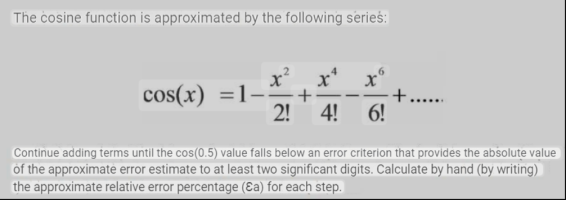circuit975
New member
- Joined
- Jul 12, 2024
- Messages
- 5

I'm faced with a question like this.
The steps I did to solve this question are as follows;
first I calculated cos(0.5) and found the result 1. T=1
and I go and as step 1; 1-(0.5^2 / 2!) = 0.875
I then calculated the relative error percentage as follows; €a = [T1 - T0 / T1] x 100 = 14.29% relative error result
As step 2; 1-(0.5^2/2!) + (0.5^4/4!) = 0.875 + 0.002604 = 0.87760 I then calculated the relative error percentage as follows; €a = [T2 - T1 / T2] x 100 = 0,30% relative error result
Step 3; 1-(0.5^2/2!) + (0.5^4/4!) - (0.5^6/6!) = -1.292396 and I'm stuck here and I don't know what to do next because the next values I find are even higher than the previous error values. Can you help me where I am making the mistake. I am already grateful to the community.
